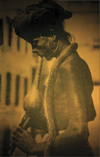Hoor-paar-Kraat, "Asha Dasha"
 Originally released in 2005 as a small run CD-R, this album has been given a much needed reissue (albeit only as a limited edition cassette). Slightly remixed, this version also includes a bonus track and new artwork. Simultaneously putting me at ease and on edge, the music is in a constant flux of emotional and sonic content. This is one of Anthony Mangicapra's more fulfilling releases from his early works and it sounds as fresh now as any of his current output.
Originally released in 2005 as a small run CD-R, this album has been given a much needed reissue (albeit only as a limited edition cassette). Slightly remixed, this version also includes a bonus track and new artwork. Simultaneously putting me at ease and on edge, the music is in a constant flux of emotional and sonic content. This is one of Anthony Mangicapra's more fulfilling releases from his early works and it sounds as fresh now as any of his current output.
Acid Casualty Productions
 
Upon pressing play on side A, I am immediately plunged into an unfamiliar environment as Mangicapra brings his listeners on a voyage through the hull of an ancient and huge ship. The sounds running through "The Purifying Order" and "Torment of the Metals" are vast, echoing through the hollow body of this imaginary vessel. Suddenly, with "Iao Habdomai," we are dropped into the center of a ritual being played out through music, the words of the spell intoned by shimmering cymbals. The effect is heady and invigorating, the feeling of some beneficent power being summoned runs through the piece, dispelling the unease previously evoked by the preceding tracks.
On side B, the music takes a different turn as foggy noises emerge from the tape. Unlike the rest of Asha Dasha, "Prepetuum Mobile" is an obviously threatening piece, waves of chilling tones running across the piece like foreboding winds; reptilian shrieks occasionally cutting through the murk, sounding too close for comfort. The bonus track, "Its & It’s," caps off the album, a burst of loudness to counter the relatively sedate sounds that made up the original album. The off-white noise that erupts from the speakers exorcises any entities that might have latched on during playback of the album before fading into nothing.
As regards the remixing of the album, there is not a huge difference between the original version of Asha Dasha and this one. Duane Hosein’s contributions have been removed but I would be hard-pressed to discern where the changes have occurred. Bearing in mind the ritualistic edge of Hoor-paar-Kraat’s music, I would wager that Hosein’s contributions were as much to do with the atmosphere as they were with the recording process. Yet all this is just trivia as Asha Dasha is still a major milestone in Mangicapra’s evolution as Hoor-paar-Kraat.
 



